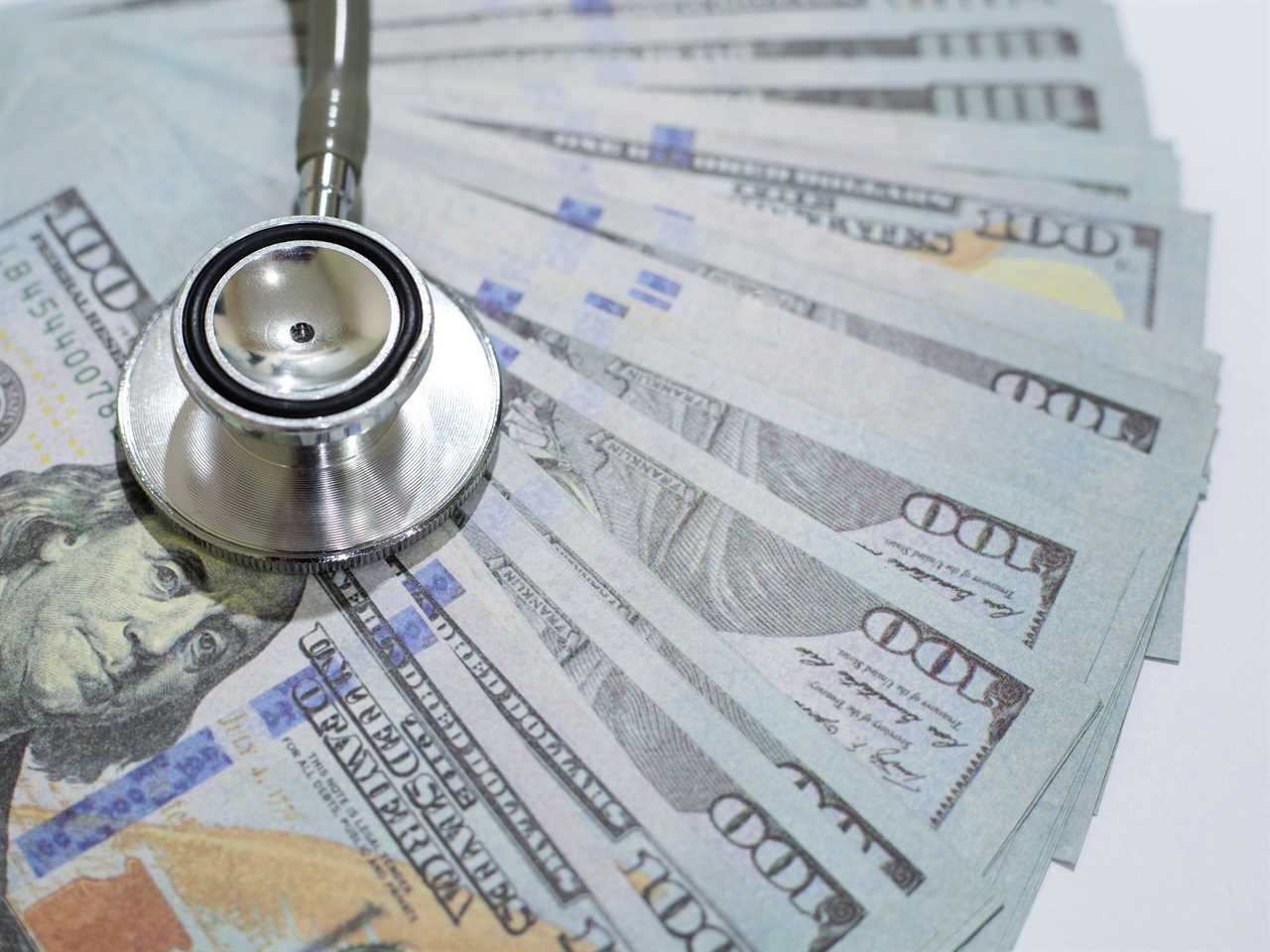Probal Rashid/LightRocket via Getty Images
- Americans are accruing billions in debt to pay for things like education and healthcare.
- Meanwhile, childcare is unaffordable almost everywhere, making it a luxury to have kids.
- They all could've been treated as public goods, but lawmakers decided to let them run as businesses.
Ron and Marcia Rizzardi still owe $130,000 in student debt despite paying off $140,000 — and starting with a loan of just $54,000.
Laura Danger had to leave the teaching job she loved because childcare for her two kids was too precarious.
And Robin O'Brien is having to choose between paying off two kinds of bills: $64,000 in student debt or medical treatment for symptoms of long COVID.
It's no wonder Americans are increasingly pessimistic about the next generation's economic prospects. A Wall Street Journal-NORC poll of 1,019 adults from March 1 to March 12 found that 78% of respondents said they did not feel confident that life for our children's generation would be better than it was for them.
That echoes a September Gallup poll, where under half of respondents said it was likely that today's youth would have a better life than their parents. Megan Brenan, a senior editor at Gallup, told Insider that this year's results were technically the lowest percentages since the polling firms began asking the question in 1996.
It may feel like everything has recently gotten worse. But it actually began over 50 years ago. With a series of political decisions, the institutions meant to prop up American life and offer pathways toward advancement — the promise of a college education, access to healthcare, and childcare that allows parents to work — have become more and more eroded, with Americans finding themselves trapped in cycles of never-ending debt and with little to no opportunity for advancement.
Many of America's biggest problems could have a policy solution. But that would require shifting the idea of childcare, education, and healthcare and thinking of them as public goods — not businesses.
Government-supported childcare helped women work during WWII, but Nixon vetoed a universal program
From the day Americans are born, their parents face no guarantees of paid parental leave or sick days off. Then, they have to scramble to afford care.
Couples with kids in the US spent an average of almost 26% of their income on childcare in 2016, according to a report from the OECD. That share reached as high as 47% in Bronx County, New York, the Department of Labor's Women's Bureau found. That's compared with nearly 0% in South Korea and 3.5% in Greece, per the OECD.
Sarah Rittling, the executive director for the First Five Years Fund, told Insider that the US's childcare situation was already "really bad" before the pandemic, saying: "I think what happened is the pandemic put a really bright light on that for people who aren't just, frankly, moms."
As childcare gets pricier, more parents — especially moms — are leaving the workforce at a time when the US needs more workers. Further data exposes the gap in who can afford to become a parent and the financial situation of those who care for children professionally. The Brookings Institution estimated it would cost a married, middle-income couple with two kids $300,000 before college tuition to raise their youngest kid given the child was born in 2015. Despite the desperate need for their services, childcare workers made a median $13.22 an hour in 2021, according to the Bureau of Labor Statistics — putting them, at the median level, just above the poverty line for a family of four.
"With the pay that we currently have, I understand why a lot of people don't want to get into this field because it's not worth it," Rachel, a preschool teacher in Washington, said. Insider agreed to withhold her last name for privacy reasons and her fear of professional repercussions; it is known to Insider.

Halfpoint Images/Getty
But it didn't have to be that way. During World War II, President Franklin Delano Roosevelt authorized funds to help keep women employed as men went to war. That ultimately meant millions in funding for public childcare.
This paved the way for the US to come very close to instituting free universal childcare for the lowest-earning Americans. A 1971 proposal specifically noted the role that childcare — or lack thereof — played in parents', especially mothers', employment.
But President Richard Nixon ultimately vetoed that bipartisan legislation. An attempt by the Biden administration to create federally funded affordable and accessible childcare also never came to fruition, with opposition from Republicans and a handful of centrist Democrats.
"Childcare is a textbook example of a broken market, and one reason is that when you pay for it, the price does not account for all the positive things it confers on our society," Treasury Secretary Janet Yellen said in 2021. "An enormous body of economic literature finds that kids with access to quality childcare end up in school longer and in higher-paying jobs afterward. When we underinvest in childcare, we forgo that; we give up a happier, healthier, more prosperous labor force in the future."
The result of all that is a hodgepodge system where childcare is different in every state and community, and for every family, Rittling said. She says she doesn't think the system is necessarily broken but imperfect, powered by people just doing their best. It's unworkable for centers to pay well without raising prices for parents. Advocates argue there has to be a buffer in the form of federal assistance.
"Something needs to give, and ultimately, when you get to the bottom line of solutions, you need more money in the system," Rittling said. "The more money that you have in the system, the more flexibility, for lack of a better word, you're going to have in doing the right thing."
College costs started to get worse when Reagan said California 'should not subsidize intellectual curiosity'
Will Bunch, a columnist for The Philadelphia Inquirer and the author of "After the Ivory Tower Falls: How College Broke the American Dream and Blew Up Our Politics — and How to Fix It," told Insider the student-debt crisis "has been kind of like the proverbial frog in boiling water."
"It's just been a matter of a few degrees every year," he said.
The mid-1960s were what Bunch called the "golden age of college." Public sentiment said higher education should be affordable and accessible — though it wasn't as rosy for women and people of color as it was for white men.
The "huge turning point" came when Ronald Reagan was elected governor of California, Bunch said. Reagan, who took the helm of a state known for its robust public-education system, said that the state "should not subsidize intellectual curiosity."

Diana Walker/Getty Images
Public intellectuals on the right fell in line, Bunch said, with more positing "that there should be a social contract where people who are getting the career and job benefits from a college degree should be investing in themselves, rather than the public making that investment."
When Reagan became president, those changes slowly started to slot into place on a national level. He slashed federal spending on education and Pell Grants, making fewer students eligible for guaranteed loans.
Tuition began to outpace how fast consumer prices were growing in the early '80s, according to the National Center for Education Statistics. From 1980 to 2020, the price of undergraduate education grew by 169%, a report from the Georgetown University Center on Education and the Workforce found.
A 2004 report from the National Center for Education Statistics said the 1992 reauthorization of Higher Education Act — which allowed people to take out bigger loans — led to an increase in borrowing that's "one of the most dramatic changes in financial aid in the decade." From 1995 to 2017, according to an analysis from the Congressional Budget Office, the total student-loan-debt balance grew from $187 billion to $1.4 trillion.
That was helped along by spiking tuition. At public four-year colleges — like those Reagan targeted — annual tuition grew from $2,000 in 1963 to $9,000 in 2020, adjusted for inflation.
And state schools are making more money by accepting out-of-state students at a higher rate, an analysis from Aaron Klein of the Brookings Institution, which crunches data from the Integrated Postsecondary Education Data System, found.
Klein calculated that the share of out-of-state students at public schools had grown by an average of 55% since 2002, while the share of in-state students fell by an average of 15%. As Slate's John Warner notes, that's a whole lot more students paying tuition that can be about double or triple what in-state students are charged.
At the same time, colleges have increasingly been running like businesses as they try to grow their income without help from state funding, raising prices and attracting donors. But college enrollment is down, and that may be due to younger people assessing whether it's worth incurring big debt for a degree. It also means some colleges are shutting down, with schools that cater to lower-income students disproportionately hit by closures, CNBC reported. The Hechinger Report found that since 2015, over 50 public and nonprofit schools had either closed or merged.
"When you talk about how to fix higher education, you're not going to really get very far unless you take a first step that we don't talk about enough," Bunch said, "which is to do a 180 on the whole societal attitude towards what higher education should be."
The big question: Is higher education a public good? "Nobody questions the idea that K-through-12 education is a public good," Bunch said. But after kids turn 18, we flip a switch. In turn, Bunch said, "we did a horrible wrong to Gen Z and the millennials who took on this student debt."
Healthcare
Dr. Elisabeth Rosenthal, the editor in chief of Kaiser Health News and the author of "An American Sickness: How Healthcare Became Big Business and How You Can Take It Back," told Insider that the US healthcare crisis had "been a kind of tsunami of costs and consolidation and loss of accessibility for the vast majority of Americans."
It has resulted in one in five Americans with medical bills currently in collections — harming their credit, blocking access to jobs, and causing bankruptcy — and $88 billion in debt, according to the Consumer Financial Protection Bureau.

krisanapong detraphiphat/Getty Images
A 2021 Census Bureau report found that 19% of US households weren't able to pay for medical care up front, and households with kids under the age of 18 were more likely to hold medical debt.
So what happened?
Health insurance itself was an outgrowth of the Great Depression. At the start, Rosenthal said, insurance initially just paid for things, which meant patients didn't know how much they cost.
"When a consumer is completely insensitive to costs, at some point, people in the industry — and it is an industry — said, 'Wait, if, if it doesn't feel like they're paying, we can just start raising prices,'" Rosenthal said. "And then it became a kind of race to the top in the end of the 20th century."
Doctors followed the hospitals jumping on that train, Rosenthal said, adding that then the drugmakers and the device makers came. All that led to an "upward spiral of prices," she added.
At the same time, in the '90s, hospitals were running on thin margins, according to Rosenthal. So they called in business consultants to see how they could raise more revenue. Of the response, Rosenthal said: "They went into hospitals and said, 'Oh, my God, there's all this stuff you're not charging for that you could be charging for. You don't have to do anything differently. You just have to bill: Bill better. Bill more."
Simultaneously, medical technology has also grown rapidly, leading to better outcomes — an undisputed good thing. But in other countries, Rosenthal said, new technology's worth isn't seen as infinite. The price of new medical technology will fall as the years go by in other countries. In the US, it stays high or gets even pricier or "is just kind of random," Rosenthal said.
For instance, in 2015, the US performed about as many MRIs as comparable countries. But an MRI in the US cost 420% more than it did in Australia and 42% more than in the UK, according to the Peterson-KFF Health System Tracker.
Hospital mergers, and hospitals buying up smaller doctor offices, can also insulate them from competition, Zack Cooper, an associate professor of health policy and economics at Yale University, told Insider.
Spending on health tripled from 1970 to 2021, according to an analysis of national health-expenditure data from the Centers for Medicare & Medicaid Services. Americans spent $4.3 trillion on health in 2021 alone.
"If the US health system was a country, it would be about the fourth-largest country in the world," Cooper said.
That's about the size of the entire German economy. That means there's space "where firms that are sort of aggressive vis-à-vis making profits and short on integrity can do some pretty horrific stuff," he said.
There's much less government involvement in the US healthcare system than in other countries, Cooper said. On the one hand, that can lead to good innovation. But the flip side is that bad actors can "do some pretty unscrupulous things," he said.
Right now, when it comes to changing the healthcare landscape, the Biden administration is taking some steps, like reining in drug prices, and the Federal Trade Commission is cracking down on hospital mergers. Rosenthal thinks there will be even more activity, but only time will tell whether it's enough to get the system under control.
"At a 50,000-foot level, it's broadly getting to a place where politicians think that their lives get better when health spending goes down, not up," Cooper said. "And I think one of the challenges that I talk about is there's no constituency in Washington, DC, for efficiency in healthcare provision.
"There's not a constituency for making the future better."
Read More
By: [email protected] (Juliana Kaplan)
Title: Healthcare, college education, and childcare started getting worse decades ago. Now we're all finally feeling it.
Sourced From: www.businessinsider.com/how-education-healthcare-childcare-got-so-expensive-feeling-it-now-2023-4
Published Date: Sat, 08 Apr 2023 10:00:00 +0000
.png)





